University Report: Interdisciplinary Studies on Cyber Bullying
VerifiedAdded on 2020/04/15
|6
|1027
|183
Report
AI Summary
This report presents an interdisciplinary analysis of cyber bullying, drawing from two articles to examine its prevalence, causes, and consequences, particularly among adolescents. The first article provides an overview of cyber bullying, its various forms, and the psychological and social impacts on victims, including anxiety, depression, and low self-esteem. It highlights the importance of prevention programs and the need for a collaborative approach involving families, schools, and society. The second article investigates the nature and prevalence of cyber victimization among elementary school children, exploring the effects of bullying on youth development and mental health. The study found that a significant percentage of children reported being cyber bullied. The report concludes by emphasizing the need for training and anti-bullying campaigns to eradicate cyber bullying and prevent related behavioral and mental health problems. The report underscores the importance of understanding the multifaceted nature of cyber bullying to develop effective prevention strategies.
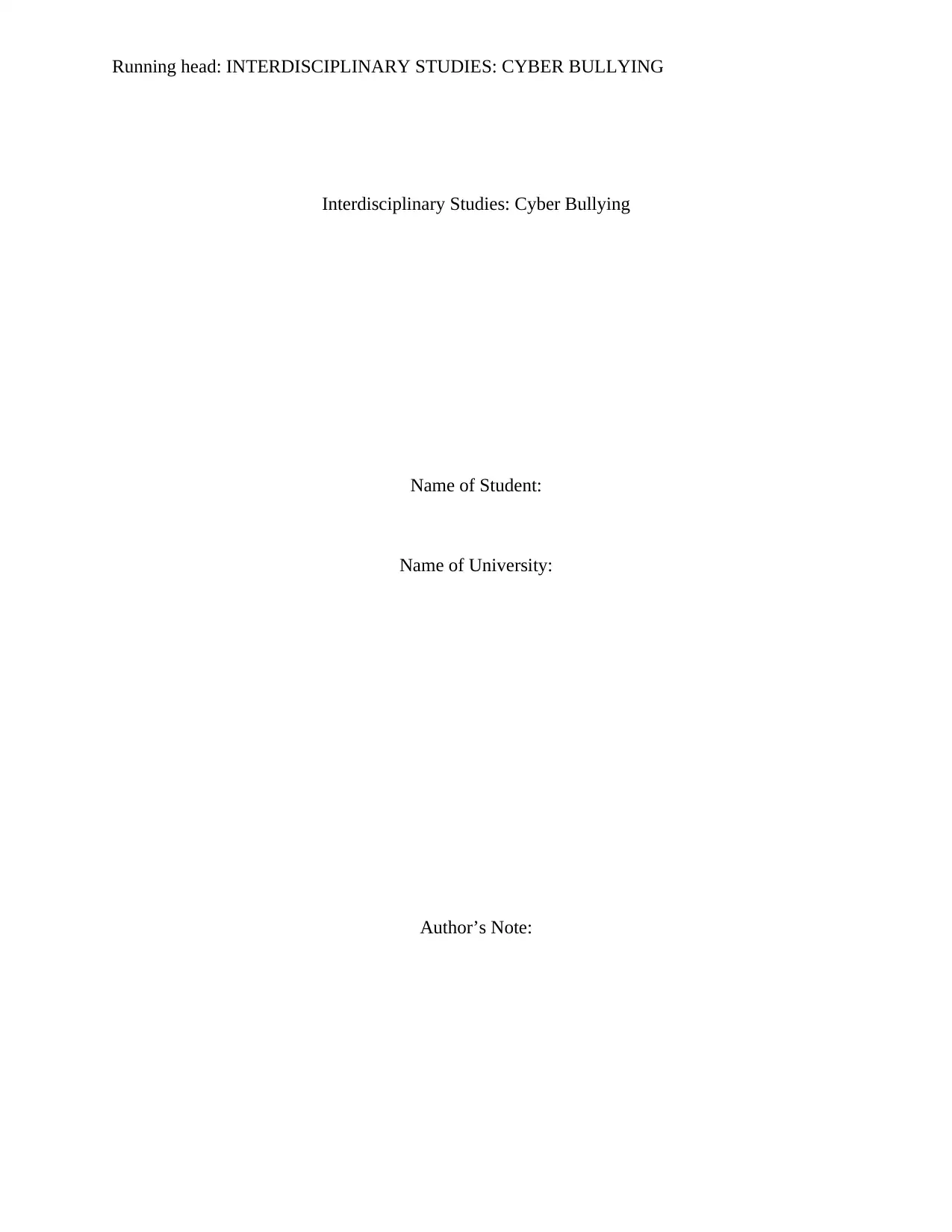
Running head: INTERDISCIPLINARY STUDIES: CYBER BULLYING
Interdisciplinary Studies: Cyber Bullying
Name of Student:
Name of University:
Author’s Note:
Interdisciplinary Studies: Cyber Bullying
Name of Student:
Name of University:
Author’s Note:
Paraphrase This Document
Need a fresh take? Get an instant paraphrase of this document with our AI Paraphraser
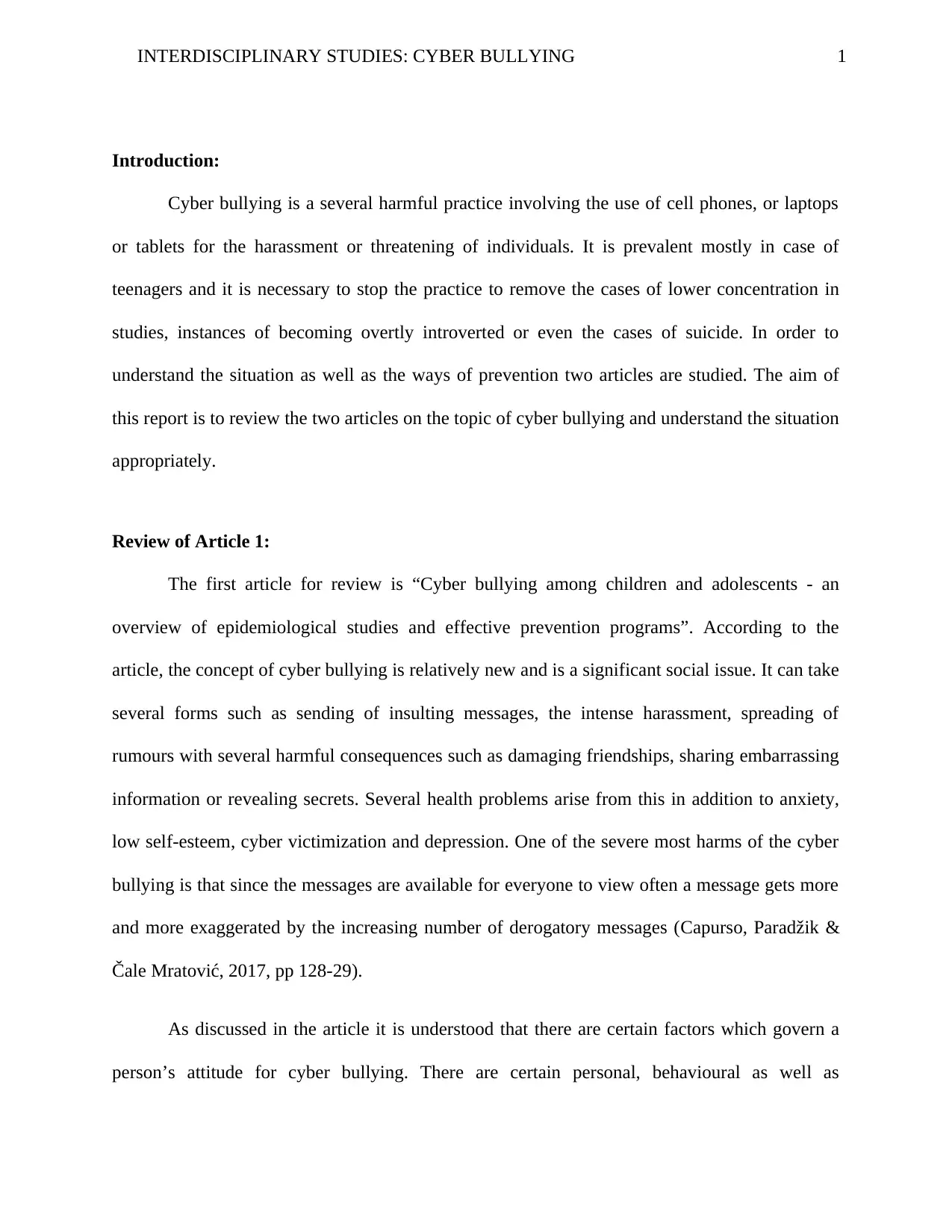
1INTERDISCIPLINARY STUDIES: CYBER BULLYING
Introduction:
Cyber bullying is a several harmful practice involving the use of cell phones, or laptops
or tablets for the harassment or threatening of individuals. It is prevalent mostly in case of
teenagers and it is necessary to stop the practice to remove the cases of lower concentration in
studies, instances of becoming overtly introverted or even the cases of suicide. In order to
understand the situation as well as the ways of prevention two articles are studied. The aim of
this report is to review the two articles on the topic of cyber bullying and understand the situation
appropriately.
Review of Article 1:
The first article for review is “Cyber bullying among children and adolescents - an
overview of epidemiological studies and effective prevention programs”. According to the
article, the concept of cyber bullying is relatively new and is a significant social issue. It can take
several forms such as sending of insulting messages, the intense harassment, spreading of
rumours with several harmful consequences such as damaging friendships, sharing embarrassing
information or revealing secrets. Several health problems arise from this in addition to anxiety,
low self-esteem, cyber victimization and depression. One of the severe most harms of the cyber
bullying is that since the messages are available for everyone to view often a message gets more
and more exaggerated by the increasing number of derogatory messages (Capurso, Paradžik &
Čale Mratović, 2017, pp 128-29).
As discussed in the article it is understood that there are certain factors which govern a
person’s attitude for cyber bullying. There are certain personal, behavioural as well as
Introduction:
Cyber bullying is a several harmful practice involving the use of cell phones, or laptops
or tablets for the harassment or threatening of individuals. It is prevalent mostly in case of
teenagers and it is necessary to stop the practice to remove the cases of lower concentration in
studies, instances of becoming overtly introverted or even the cases of suicide. In order to
understand the situation as well as the ways of prevention two articles are studied. The aim of
this report is to review the two articles on the topic of cyber bullying and understand the situation
appropriately.
Review of Article 1:
The first article for review is “Cyber bullying among children and adolescents - an
overview of epidemiological studies and effective prevention programs”. According to the
article, the concept of cyber bullying is relatively new and is a significant social issue. It can take
several forms such as sending of insulting messages, the intense harassment, spreading of
rumours with several harmful consequences such as damaging friendships, sharing embarrassing
information or revealing secrets. Several health problems arise from this in addition to anxiety,
low self-esteem, cyber victimization and depression. One of the severe most harms of the cyber
bullying is that since the messages are available for everyone to view often a message gets more
and more exaggerated by the increasing number of derogatory messages (Capurso, Paradžik &
Čale Mratović, 2017, pp 128-29).
As discussed in the article it is understood that there are certain factors which govern a
person’s attitude for cyber bullying. There are certain personal, behavioural as well as
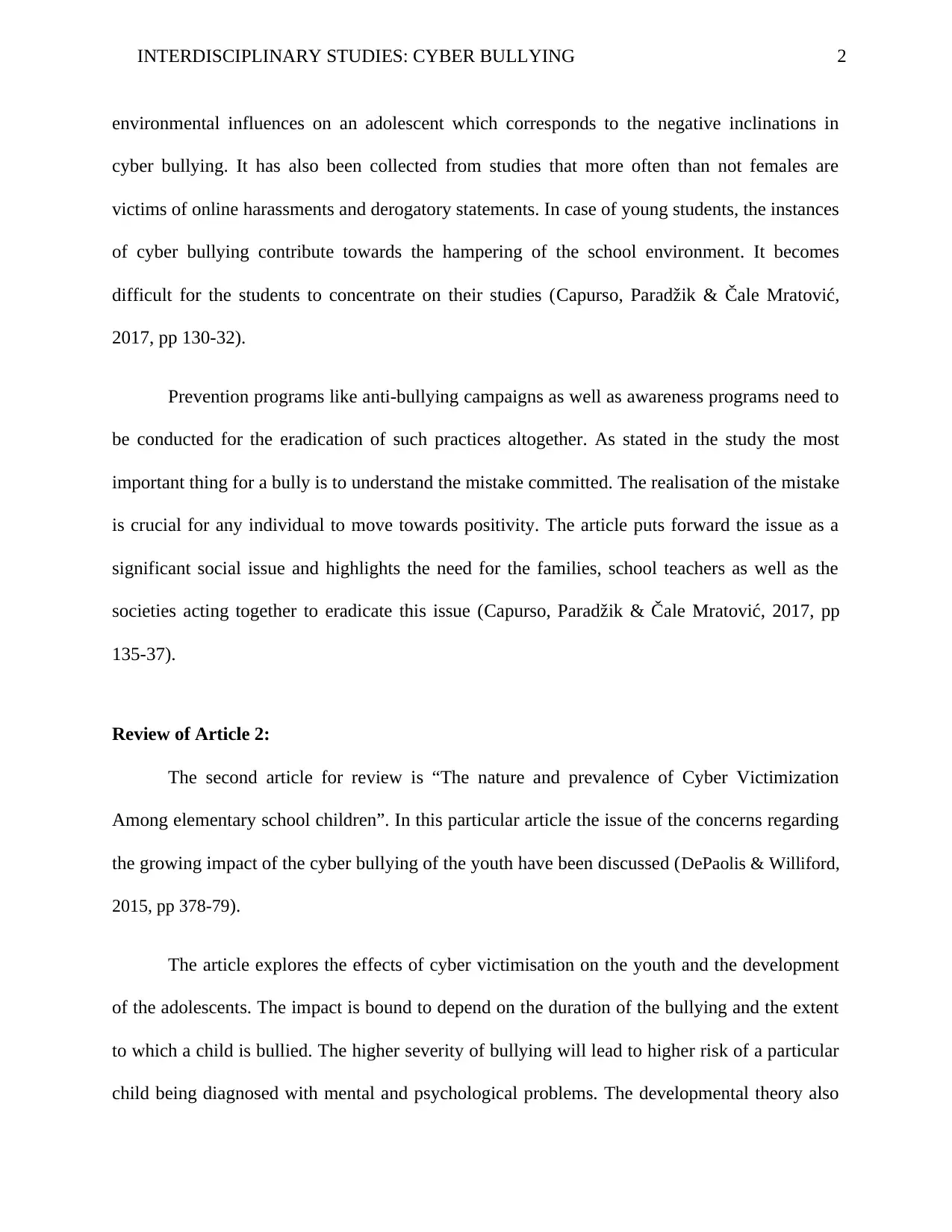
2INTERDISCIPLINARY STUDIES: CYBER BULLYING
environmental influences on an adolescent which corresponds to the negative inclinations in
cyber bullying. It has also been collected from studies that more often than not females are
victims of online harassments and derogatory statements. In case of young students, the instances
of cyber bullying contribute towards the hampering of the school environment. It becomes
difficult for the students to concentrate on their studies (Capurso, Paradžik & Čale Mratović,
2017, pp 130-32).
Prevention programs like anti-bullying campaigns as well as awareness programs need to
be conducted for the eradication of such practices altogether. As stated in the study the most
important thing for a bully is to understand the mistake committed. The realisation of the mistake
is crucial for any individual to move towards positivity. The article puts forward the issue as a
significant social issue and highlights the need for the families, school teachers as well as the
societies acting together to eradicate this issue (Capurso, Paradžik & Čale Mratović, 2017, pp
135-37).
Review of Article 2:
The second article for review is “The nature and prevalence of Cyber Victimization
Among elementary school children”. In this particular article the issue of the concerns regarding
the growing impact of the cyber bullying of the youth have been discussed (DePaolis & Williford,
2015, pp 378-79).
The article explores the effects of cyber victimisation on the youth and the development
of the adolescents. The impact is bound to depend on the duration of the bullying and the extent
to which a child is bullied. The higher severity of bullying will lead to higher risk of a particular
child being diagnosed with mental and psychological problems. The developmental theory also
environmental influences on an adolescent which corresponds to the negative inclinations in
cyber bullying. It has also been collected from studies that more often than not females are
victims of online harassments and derogatory statements. In case of young students, the instances
of cyber bullying contribute towards the hampering of the school environment. It becomes
difficult for the students to concentrate on their studies (Capurso, Paradžik & Čale Mratović,
2017, pp 130-32).
Prevention programs like anti-bullying campaigns as well as awareness programs need to
be conducted for the eradication of such practices altogether. As stated in the study the most
important thing for a bully is to understand the mistake committed. The realisation of the mistake
is crucial for any individual to move towards positivity. The article puts forward the issue as a
significant social issue and highlights the need for the families, school teachers as well as the
societies acting together to eradicate this issue (Capurso, Paradžik & Čale Mratović, 2017, pp
135-37).
Review of Article 2:
The second article for review is “The nature and prevalence of Cyber Victimization
Among elementary school children”. In this particular article the issue of the concerns regarding
the growing impact of the cyber bullying of the youth have been discussed (DePaolis & Williford,
2015, pp 378-79).
The article explores the effects of cyber victimisation on the youth and the development
of the adolescents. The impact is bound to depend on the duration of the bullying and the extent
to which a child is bullied. The higher severity of bullying will lead to higher risk of a particular
child being diagnosed with mental and psychological problems. The developmental theory also
⊘ This is a preview!⊘
Do you want full access?
Subscribe today to unlock all pages.

Trusted by 1+ million students worldwide
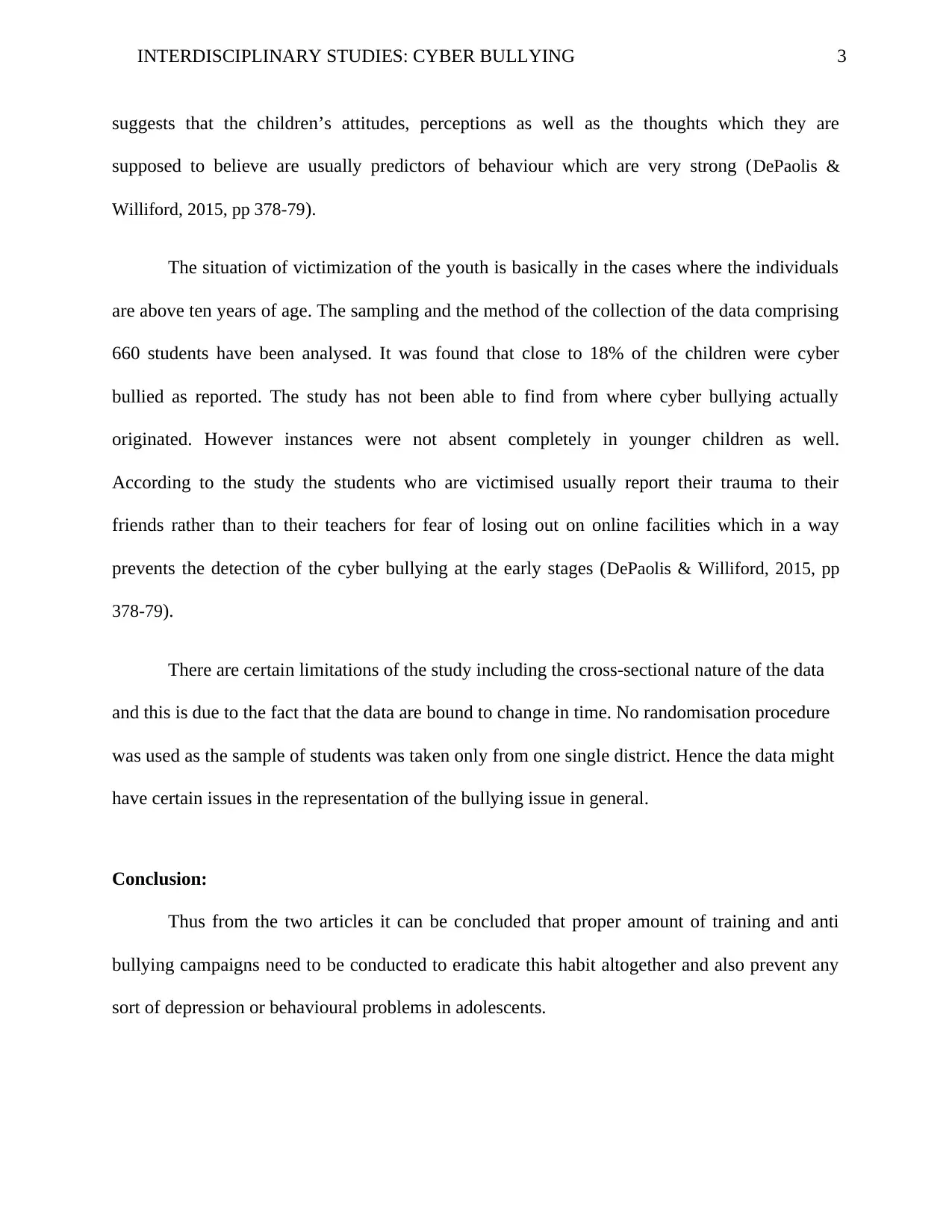
3INTERDISCIPLINARY STUDIES: CYBER BULLYING
suggests that the children’s attitudes, perceptions as well as the thoughts which they are
supposed to believe are usually predictors of behaviour which are very strong (DePaolis &
Williford, 2015, pp 378-79).
The situation of victimization of the youth is basically in the cases where the individuals
are above ten years of age. The sampling and the method of the collection of the data comprising
660 students have been analysed. It was found that close to 18% of the children were cyber
bullied as reported. The study has not been able to find from where cyber bullying actually
originated. However instances were not absent completely in younger children as well.
According to the study the students who are victimised usually report their trauma to their
friends rather than to their teachers for fear of losing out on online facilities which in a way
prevents the detection of the cyber bullying at the early stages (DePaolis & Williford, 2015, pp
378-79).
There are certain limitations of the study including the cross-sectional nature of the data
and this is due to the fact that the data are bound to change in time. No randomisation procedure
was used as the sample of students was taken only from one single district. Hence the data might
have certain issues in the representation of the bullying issue in general.
Conclusion:
Thus from the two articles it can be concluded that proper amount of training and anti
bullying campaigns need to be conducted to eradicate this habit altogether and also prevent any
sort of depression or behavioural problems in adolescents.
suggests that the children’s attitudes, perceptions as well as the thoughts which they are
supposed to believe are usually predictors of behaviour which are very strong (DePaolis &
Williford, 2015, pp 378-79).
The situation of victimization of the youth is basically in the cases where the individuals
are above ten years of age. The sampling and the method of the collection of the data comprising
660 students have been analysed. It was found that close to 18% of the children were cyber
bullied as reported. The study has not been able to find from where cyber bullying actually
originated. However instances were not absent completely in younger children as well.
According to the study the students who are victimised usually report their trauma to their
friends rather than to their teachers for fear of losing out on online facilities which in a way
prevents the detection of the cyber bullying at the early stages (DePaolis & Williford, 2015, pp
378-79).
There are certain limitations of the study including the cross-sectional nature of the data
and this is due to the fact that the data are bound to change in time. No randomisation procedure
was used as the sample of students was taken only from one single district. Hence the data might
have certain issues in the representation of the bullying issue in general.
Conclusion:
Thus from the two articles it can be concluded that proper amount of training and anti
bullying campaigns need to be conducted to eradicate this habit altogether and also prevent any
sort of depression or behavioural problems in adolescents.
Paraphrase This Document
Need a fresh take? Get an instant paraphrase of this document with our AI Paraphraser

4INTERDISCIPLINARY STUDIES: CYBER BULLYING
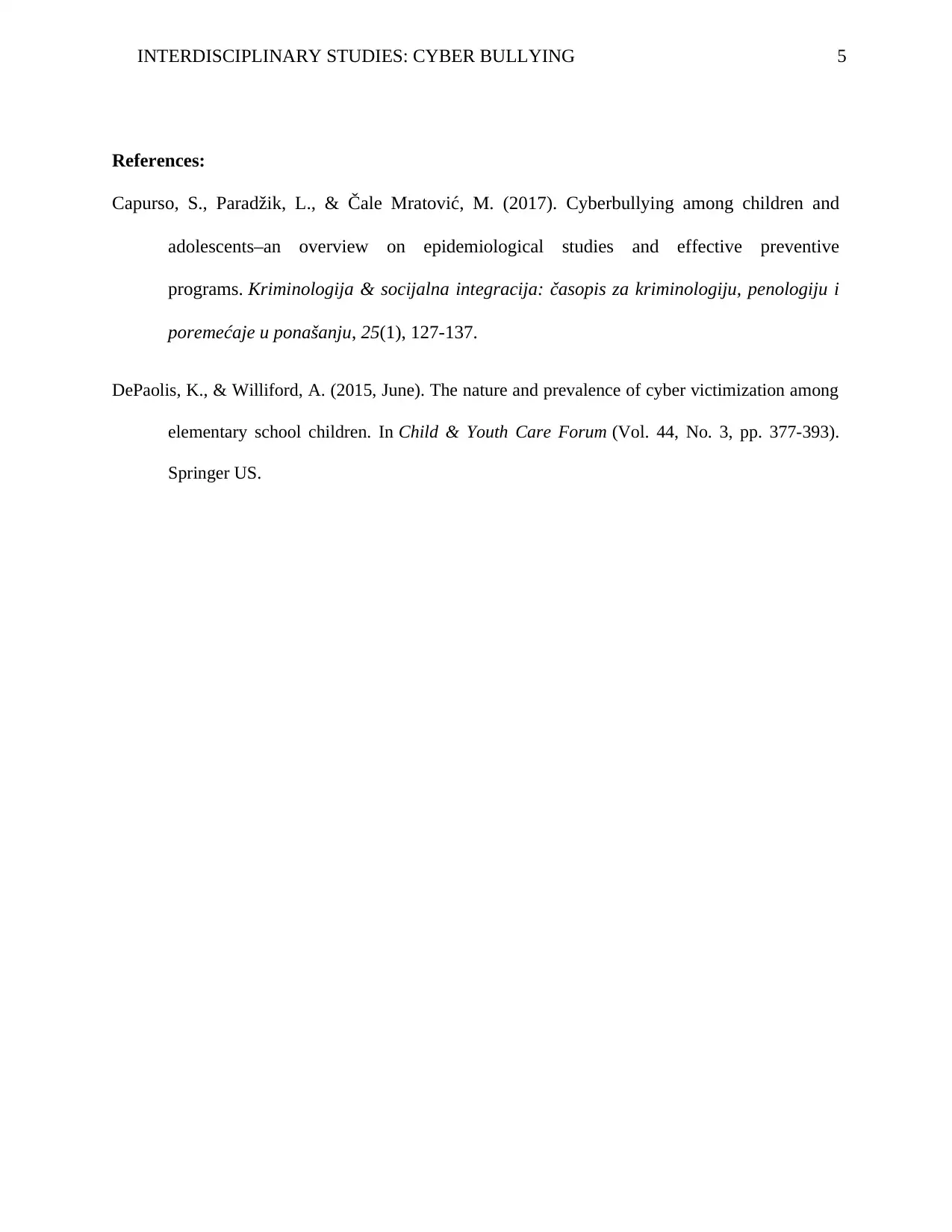
5INTERDISCIPLINARY STUDIES: CYBER BULLYING
References:
Capurso, S., Paradžik, L., & Čale Mratović, M. (2017). Cyberbullying among children and
adolescents–an overview on epidemiological studies and effective preventive
programs. Kriminologija & socijalna integracija: časopis za kriminologiju, penologiju i
poremećaje u ponašanju, 25(1), 127-137.
DePaolis, K., & Williford, A. (2015, June). The nature and prevalence of cyber victimization among
elementary school children. In Child & Youth Care Forum (Vol. 44, No. 3, pp. 377-393).
Springer US.
References:
Capurso, S., Paradžik, L., & Čale Mratović, M. (2017). Cyberbullying among children and
adolescents–an overview on epidemiological studies and effective preventive
programs. Kriminologija & socijalna integracija: časopis za kriminologiju, penologiju i
poremećaje u ponašanju, 25(1), 127-137.
DePaolis, K., & Williford, A. (2015, June). The nature and prevalence of cyber victimization among
elementary school children. In Child & Youth Care Forum (Vol. 44, No. 3, pp. 377-393).
Springer US.
⊘ This is a preview!⊘
Do you want full access?
Subscribe today to unlock all pages.

Trusted by 1+ million students worldwide
1 out of 6
Related Documents
Your All-in-One AI-Powered Toolkit for Academic Success.
+13062052269
info@desklib.com
Available 24*7 on WhatsApp / Email
![[object Object]](/_next/static/media/star-bottom.7253800d.svg)
Unlock your academic potential
Copyright © 2020–2025 A2Z Services. All Rights Reserved. Developed and managed by ZUCOL.




